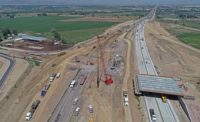The Colorado Transportation Commission unanimously approved updates to long-term transportation plans from the Colorado Dept. of Transportation (CDOT) and the Denver Regional Council of Governments (DRCOG) on Sept. 15. The DRCOG board will vote on the plan on Sept. 21.
CDOT spokesperson Matthew Inzeo says the updates are the result of a statewide mandate to reduce greenhouse gas emissions. “That really was the thrust of the most recent effort,” he says.
He says the state is embarking on $1.7 billion in capital projects over the next five years that will reduce CO2 emission by an estimated 1.3 million metric tons. “Either one of those is monumental. The fact that we do it tied together […] is something that we’re proud of, particularly as we lead the nation in this type of effort.”
Projects that are part of the plan include adding lanes and smoothing curves on I-70 between Floyd Hill and Idaho Springs, and adding a lane on I-25 north of Denver to Fort Collins, but the update delayed a major project on I-25 in central Denver in favor of a more multimodal approach with expanded bus rapid transit (BRT) projects and more routes for Bustang, the state’s intercity bus service. East of Denver, the plan also encompasses updates to antiquated stretches of I-70 and I-76.
Inzeo says groundbreaking for the “iconic” Floyd Hill project will take place in fall 2022 and will require at least four years to complete.
“You see the project mix change most acutely in central Denver,” says Inzeo. “From a statewide perspective, there are certainly tweaks and changes, but this is an ambitious capital construction plan that we’re moving forward with.”
In metro Denver, DRCOG’s update to the 2050 Metro Vision Regional Transportation Plan largely involved a reprioritization, says Jacob Riger, the long-range transportation planning manager for DRCOG’s Transportation Planning and Operations Division.
“In responding to the state greenhouse gas planning standard, we have done a few things,” says Riger. “There are two highway projects—central I-25 and a section of C-470—that are still in the plan, but working with project stakeholders, particularly CDOT, we have mutually modified the scope of those projects to focus more on safety, bottlenecks, operations, transit and community connections.” Additional lanes are no longer part of the plans for the project, he adds.
Instead, the plan accelerated “a very robust BRT network across the region, 10 to 12 corridors to implement over the 30 years of the plan,” he says. Five BRT routes—including corridors on East Colfax Avenue State Highway 119 between Boulder and Longmont, and Colorado Boulevard—are now slated for completion by 2030.
The updated plan also allocates $900 million to “non-project-specific investments” to help mitigate emissions and enhance safety, such as bike paths, sidewalks and intersection improvements, adds Riger.
The emphasis on safe, multimodal projects “is an ongoing trend,” says Chris Vogelsang, principal engineer at Denver-based transportation planning firm OV Consulting. “We still spend a lot of money on roads, so that isn’t going away, but in traffic engineering, we’ve always been focused on safety, and we’ve seen much more buy-in in terms of safety being a top priority over capacity.”
“The big disappointment for some folks was central I-25,” says Vogelsang, but he praised the update for its broader approach. “Smart, focused spending and improving safety I think is good for everybody, and I think it’s good for the industry too.”




Post a comment to this article
Report Abusive Comment